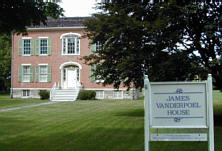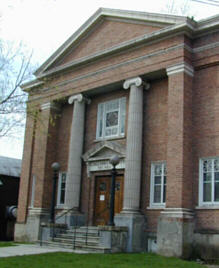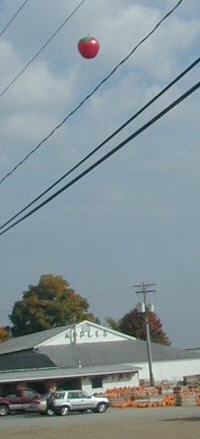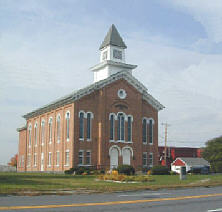KINDERHOOKNEW YORK |
 |
KINDERHOOKNEW YORK |
 |
Knox Trail — During the months of November, December and January, 1775-1776, Henry Knox led a transportation unit that brought artillery from Fort Ticonderoga and Crown Point for a siege of Boston. The 300-mile route taken by Knox is called the Knox Trail. Knox did not have the benefit of good roads or wagons for the trip. They used flat-bottom scows across Lake George, specially constructed sleds across snow, ice and frozen lakes and they completed the journey in trains pulled by horses and oxen. They transported 44 cannons, 14 mortars and one howitzer. The Knox Trail marker has a map on it that shows the route taken by General Knox. The route includes Fort George, Fort Edward, Saratoga, Half-moon, Albany, Kinderhook, Claverack, Nobletown and finally Cambridge. Although Claverack is the turning point from south to east on the marker, one wonders where the marker is in Claverack.
|
Through this place passed Gen. Henry Knox in the winter of 1775-1776 to deliver to Gen. George Washington at Cambridge the train of artillery from Fort Ticonderoga used to force the British Army to evacuate Boston. Erected by the State of New York during the Sesquicentennial of the American Revolution. (Kinderhook Marker) |
|
Reformed Dutch Church — The congregation, among the first in New York State, was formed in 1712.
| Reformed
Dutch Church
Organized in 1712, the sixth church between New York and Albany. State Education Department 1932 (Kinderhook Marker) |
|
Benedict Arnold House — In the second battle of Saratoga (the battle of Bemis Heights), Benedict Arnold was a true hero. Disobeying the orders of General Horatio Gates and without any regard for his own safety, he almost single-handedly rallied the Americans to victory at Saratoga, a victory that is recognized as the turning point in the American Revolution. General John Burgoyne surrendered and over 5,000 British soldiers became prisoners of war.
| Benedict
Arnold House
According to tradition, Benedict Arnold was brought here after being wounded at the battle of Bemis Heights, 1777. Erected 1959 (Kinderhook Marker) |
|
Benedict Arnold was, no doubt, a very complex person. At the beginning of this road trip, we saw where Benedict Arnold took flight and became a traitor to the American cause. At the end of this road trip at Saratoga, we will see Benedict Arnold, a war hero — a true dichotomy.
Burgoyne House — This home was a stopping place for General John Burgoyne on his way to Boston. He was held here as both a prisoner and a guest.
| General John
Burgoyne
As prisoner of war, was entertained in this house on the night of October 22, 1777. While being taken from the Battle of Saratoga to Boston. State Education Department (Kinderhook Marker) |
|
 Vanderpoel
House — Not far from the “Burgoyne House” is the James Vanderpoel
House. Vanderpoel was born shortly after the Revolution in 1787 and served the
state of New York with distinction as a lawyer and judge. Today, the house is a
fine example of Federal period architecture and is owned by the Columbia County
Historical Society.
Vanderpoel
House — Not far from the “Burgoyne House” is the James Vanderpoel
House. Vanderpoel was born shortly after the Revolution in 1787 and served the
state of New York with distinction as a lawyer and judge. Today, the house is a
fine example of Federal period architecture and is owned by the Columbia County
Historical Society. 
Columbia County Museum — A block west on Albany Street is the Columbia County Museum. It houses a research library, collections storage, and exhibit space. It is the current home of the Columbia County Historical Society.
Lunch in Kinderhook — Near the Vanderpoel House are a couple spots
for lunch. Across the street is Bagel Tyme. They have great soups and bagel
sandwiches. Just up the street from the Vanderpoel house is Valaggio’s
Pizzeria. Their pizza has won awards.
Quackenboss Tavern Marker.
| Quackenboss
Tavern
Here in 1753 for two months sat commissioners to divide the great Kinderhook patent of 1686. Martin Van Buren later tried a law case here. State Education Department (US Route 9 Marker) |
|
 Big
Apple -- Floating overhead. What could be a more appropriate site in the
heart of New York State? There are several opportunities to purchase apples
along this section of US Route 9. Not to be missed is a cup of hot apple cider
and a cider donut.
Big
Apple -- Floating overhead. What could be a more appropriate site in the
heart of New York State? There are several opportunities to purchase apples
along this section of US Route 9. Not to be missed is a cup of hot apple cider
and a cider donut.
 East
Greenbush Reformed Church -- There is another Knox Trail marker in front of
the church.
East
Greenbush Reformed Church -- There is another Knox Trail marker in front of
the church.
 Fort Crailo -- A distinctive, 18th century home overlooking the Hudson
River. It is the legendary home of the patriotic song “Yankee Doodle,”
penned during the French and Indian War. Today, Fort Crailo is
a museum that
depicts early Dutch life in the upper Hudson River Valley. It is open for tours
from Wednesday-Saturday from 10 a.m. to 5 p.m.
Fort Crailo -- A distinctive, 18th century home overlooking the Hudson
River. It is the legendary home of the patriotic song “Yankee Doodle,”
penned during the French and Indian War. Today, Fort Crailo is
a museum that
depicts early Dutch life in the upper Hudson River Valley. It is open for tours
from Wednesday-Saturday from 10 a.m. to 5 p.m.
From the park across from Fort Crailo, you can see the Albany
Harbor and the Port of Albany. Docked in the Albany Harbor is the Dutch Apple
II, a small cruise ship that tours the Hudson near Albany. Also docked in the
harbor is the USS Slater, a destroyer escort ship that did service during World
War II. Both ships and Fort Crailo are recommended stops on a longer visit to
the Albany Area.
